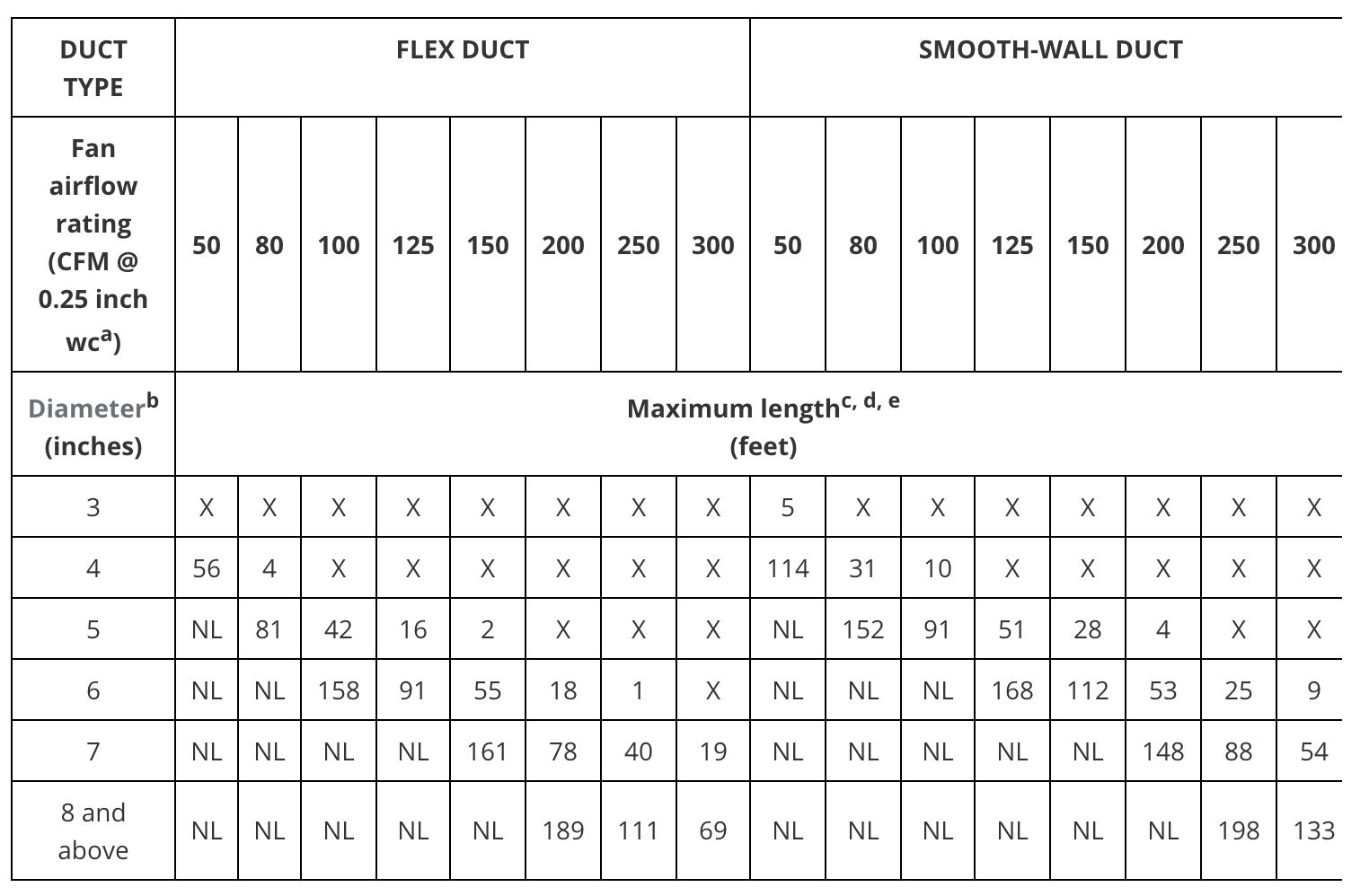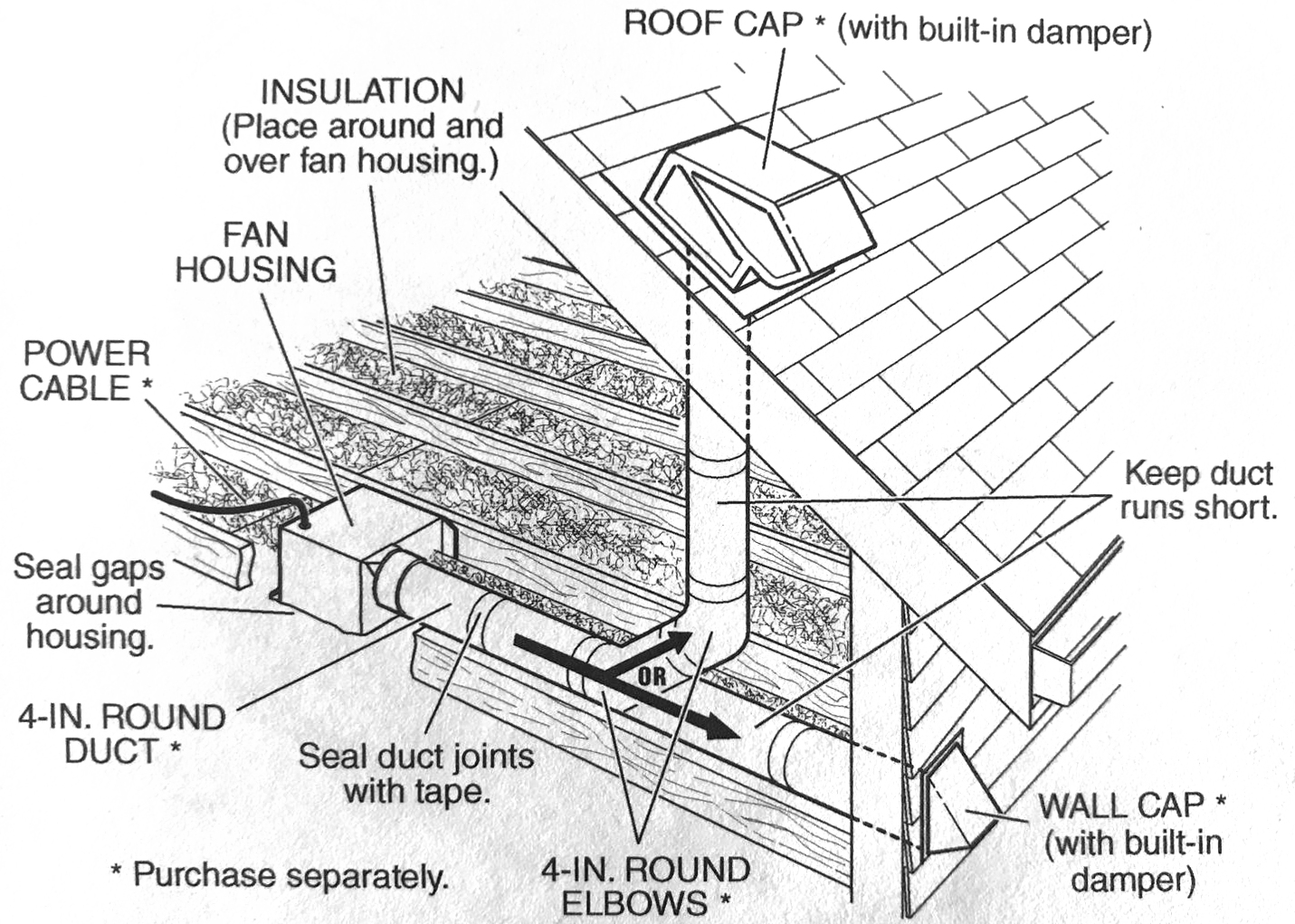Understanding Maximum Length Bathroom Exhaust Vent Regulations

Proper ventilation is crucial for maintaining a healthy and comfortable bathroom environment. Bathrooms are susceptible to moisture buildup due to showers, baths, and other activities that generate steam. This moisture can lead to mold growth, mildew, and other problems that can affect the air quality and overall health of the home. Exhaust vents play a vital role in removing moisture and odors from the bathroom, ensuring a fresh and clean atmosphere.
Bathroom Exhaust Vent Length Regulations
Building codes and regulations establish maximum lengths for bathroom exhaust vents to ensure effective ventilation. These regulations vary depending on the location and the size of the bathroom. Exceeding the maximum vent length can significantly reduce the effectiveness of the exhaust fan, making it difficult to remove moisture and odors.
Here is a table outlining the maximum vent length for different bathroom sizes and types of exhaust fans:
| Bathroom Size (sq. ft.) | Exhaust Fan CFM | Maximum Vent Length (ft.) |
|---|---|---|
| 50-75 | 50-75 | 25 |
| 75-100 | 75-100 | 30 |
| 100-150 | 100-150 | 35 |
Note: These are general guidelines and may vary depending on local building codes and the specific type of exhaust fan used. It is always best to consult with a qualified contractor or building inspector to ensure compliance with local regulations.
Consequences of Exceeding Maximum Vent Length
Exceeding the maximum vent length can have several negative consequences:
- Reduced Ventilation Effectiveness: Longer vents increase friction and resistance, reducing the airflow and effectiveness of the exhaust fan. This can lead to moisture buildup, mold growth, and a musty smell in the bathroom.
- Increased Energy Consumption: A less effective exhaust fan will need to run longer to remove moisture, leading to increased energy consumption and higher utility bills.
- Safety Hazards: Moisture buildup can create a breeding ground for mold and bacteria, posing health risks to occupants, especially those with allergies or respiratory problems.
- Code Violations: Exceeding maximum vent length can result in building code violations, leading to fines and potential legal issues.
Factors Influencing Maximum Vent Length

The maximum length of a bathroom exhaust vent is influenced by several factors, including the type of vent material, its diameter, the CFM rating of the exhaust fan, and the routing of the vent. Understanding these factors is crucial for ensuring proper ventilation and preventing moisture buildup in the bathroom.
Vent Material
The type of vent material used can significantly impact the maximum length of the vent. Different materials have varying levels of friction and resistance to airflow, which affects the overall ventilation efficiency.
- PVC (Polyvinyl Chloride): PVC is a common and cost-effective vent material known for its durability and resistance to moisture. However, PVC can have higher friction than other materials, limiting the maximum vent length. PVC vents are suitable for shorter runs, typically up to 25 feet.
- ABS (Acrylonitrile Butadiene Styrene): ABS is another popular choice for vent material due to its affordability and ease of installation. ABS has similar friction characteristics to PVC, making it suitable for shorter vent runs.
- Metal (Aluminum or Galvanized Steel): Metal vents are generally more durable and offer lower friction than PVC or ABS. They are often preferred for longer vent runs and can extend up to 50 feet or more. Metal vents also provide better resistance to high temperatures and potential fire hazards.
Vent Diameter
The diameter of the vent plays a critical role in determining the maximum length. A larger diameter vent allows for greater airflow, reducing the resistance and enabling longer vent runs. A larger diameter vent can handle more air volume, ensuring efficient ventilation even over longer distances.
For example, a 4-inch diameter vent can typically support a longer run than a 3-inch diameter vent, all other factors being equal.
Exhaust Fan CFM
The CFM (cubic feet per minute) rating of the exhaust fan is directly related to the amount of air it moves. A higher CFM rating indicates a more powerful fan, allowing for longer vent runs.
A fan with a CFM rating of 100 can potentially handle a longer vent run than a fan with a CFM rating of 50.
Vent Routing and Bends
The routing and number of bends in the vent can also affect the maximum length. Each bend in the vent creates resistance to airflow, reducing the overall ventilation efficiency.
- Straight Runs: Straight vent runs with minimal bends offer the least resistance to airflow, allowing for longer vent lengths.
- Bends: Each bend in the vent increases the resistance to airflow, reducing the effective length. A vent with multiple bends will require a shorter overall length compared to a straight run.
Visual Representation
[Visual Representation Placeholder]
A visual representation comparing different vent materials and their maximum length capabilities could be a chart or diagram showing the maximum length achievable with each material type, considering factors like diameter, CFM rating, and number of bends.
Determining Maximum Vent Length for Specific Applications: Maximum Length Bathroom Exhaust Vent

Knowing the maximum vent length for your bathroom is crucial for ensuring proper ventilation and preventing moisture buildup, which can lead to mold growth and other problems. While regulations provide general guidelines, calculating the maximum vent length for your specific bathroom involves several factors.
Calculating Maximum Vent Length
To calculate the maximum vent length for your bathroom, you’ll need to consider the following factors:
- Bathroom Size: The larger the bathroom, the longer the vent can be.
- Vent Diameter: Larger diameter vents allow for greater airflow and can handle longer runs.
- Vent Material: Some materials, like PVC, are more efficient than others, allowing for longer vent runs.
- Number of Bends: Each bend in the vent restricts airflow, so the more bends, the shorter the vent run should be.
- Fan CFM: The fan’s cubic feet per minute (CFM) rating determines the amount of air it can move. Higher CFM fans can handle longer vent runs.
Here’s a step-by-step guide to calculate the maximum vent length for your bathroom:
- Determine your bathroom’s size. Measure the length and width of the bathroom, and multiply them to get the area.
- Choose your vent diameter. A 4-inch diameter vent is generally recommended for most bathrooms.
- Select a vent material. PVC is a popular choice due to its durability and affordability.
- Count the number of bends in the vent run. Each 90-degree bend is equivalent to 5 feet of straight vent run.
- Determine the fan’s CFM rating. Check the fan’s specifications for its CFM rating.
- Use a vent length calculator or online resource. These tools take all the factors mentioned above into account and provide an accurate estimate of the maximum vent length for your bathroom.
Optimizing Vent Length and Placement, Maximum length bathroom exhaust vent
Optimizing vent length and placement is crucial for maximizing ventilation efficiency:
- Minimize bends: Keep the vent run as straight as possible to reduce airflow resistance.
- Place the vent near the shower or tub: This ensures that the exhaust fan can quickly remove moisture from the area where it’s generated.
- Ensure adequate slope: The vent should slope upwards towards the exterior vent to prevent water from accumulating in the vent line.
- Consider the vent termination point: The vent should terminate at least 10 feet above ground level to prevent backdrafting.
Benefits of Using a Vent Length Calculator
Using a vent length calculator or online resource offers several benefits:
- Accuracy: These tools provide accurate calculations based on industry standards and best practices.
- Convenience: They eliminate the need for manual calculations, saving you time and effort.
- Clarity: They clearly present the results, making it easy to understand the maximum vent length for your bathroom.
Examples of Real-World Bathroom Layouts and Maximum Vent Lengths
Here are some examples of real-world bathroom layouts and their corresponding maximum vent lengths:
A 5×8 feet bathroom with a 4-inch diameter PVC vent, one 90-degree bend, and a fan with a CFM rating of 100, can have a maximum vent length of approximately 25 feet.
A 10×12 feet bathroom with a 6-inch diameter PVC vent, two 90-degree bends, and a fan with a CFM rating of 200, can have a maximum vent length of approximately 40 feet.
Maximum length bathroom exhaust vent – The maximum length of a bathroom exhaust vent is crucial for proper ventilation, and it’s often dictated by local building codes. While focusing on the mechanics of air flow, don’t forget about the security and privacy of your bathroom space, which is enhanced by a reliable door lock like a Schlage bathroom door lock.
A well-functioning exhaust vent paired with a secure door lock ensures a comfortable and safe bathroom experience.
When it comes to bathroom exhaust vents, the maximum length is crucial for efficient ventilation. This is especially important in humid climates like the Philippines, where a well-ventilated bathroom is essential for maintaining a healthy environment. If you’re considering a modern bathroom design, check out this guide to bathroom sliding glass doors in the Philippines , which can add a touch of elegance while still ensuring proper ventilation.
Remember, a well-functioning exhaust vent system is key to preventing moisture buildup and mold growth, regardless of the style choices you make for your bathroom.